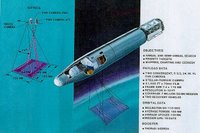Japan's Reliance on U.S Spy Satellites and Early Warning Missile Systems
0 With China breathing down Japan's neck, and North Korea crying for attention by actively experimenting with symmetric and asymmetric warfare capabilities, Japan's need for better reconnaissance, and limiting of its imagery gathering dependence has been in the execution stage for years as Reliance on U.S. intelligence on missile launch shows need for improvement :
With China breathing down Japan's neck, and North Korea crying for attention by actively experimenting with symmetric and asymmetric warfare capabilities, Japan's need for better reconnaissance, and limiting of its imagery gathering dependence has been in the execution stage for years as Reliance on U.S. intelligence on missile launch shows need for improvement :"The two spy satellites currently in operation are both polar orbiters circling the globe at altitudes of 400 to 600 kilometers. If the fourth, a SAR satellite, is launched in 2007 as planned, it will complete the four-satellite reconnaissance system, and the country will be able to monitor any point on Earth at least once a day, officials said. It will therefore become possible for Japan to monitor day-to-day changes in North Korean missile-launching sites. The problem, however, is if the system will be effective at the moment of a missile launch, which would depend on the weather and positions of the satellites at the time, officials said on condition of anonymity. In stark contrast with Japan, the United States has orbited more than 100 satellites, at least 15 of which are reportedly for intelligence-gathering purposes, they said. As experts put it, the U.S. satellites can identify objects as small as 8 to 9 centimeters in size if weather conditions are ideal. The United States has five early-warning satellites, including one for backup purposes, keeping watch over North Korea around the clock, they said."
 They're definitely using open source IMINT on North Korea as well, or requesting detailed imagery on demand through commercial providers, in between further developing their early warning systems. Go through an article on Japan's Information Gathering Satellites Imagery Intelligence in case you're interested in their past efforts in this direction. However, I feel it's their neighbors' cyber warfare capabilities they should be also worried about.
They're definitely using open source IMINT on North Korea as well, or requesting detailed imagery on demand through commercial providers, in between further developing their early warning systems. Go through an article on Japan's Information Gathering Satellites Imagery Intelligence in case you're interested in their past efforts in this direction. However, I feel it's their neighbors' cyber warfare capabilities they should be also worried about.Image courtesy of Northrop Grumman.

0 Comments: